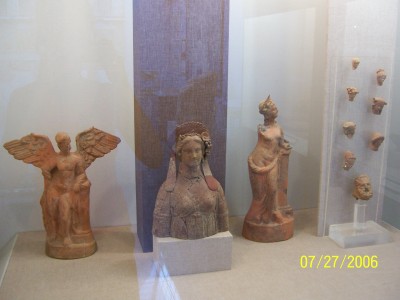|
Pella
 Pella,
the capital of Macedonia (an area in Northern Greece) during the time of Philip
and Alexander, will be an amazing archeological site one day. The agora there is
70,000 square meters (roughly 10 football fields). Pella,
the capital of Macedonia (an area in Northern Greece) during the time of Philip
and Alexander, will be an amazing archeological site one day. The agora there is
70,000 square meters (roughly 10 football fields).
At present, there are some beautiful
mosaics to be seen and lots of archeologists.
The museum gives insight into the daily
life of people there, including their religious practices (which as in Dion and
elsewhere, included Dioynsis, Aphrodite, Asklepius, and Demeter worship).
One interesting point is that the museum
indicated that people often had household gods, ie, idols, around the house for
protection. A few of these are shown in this photo.
How is Pella significant for
understanding the world of Paul?
The belief that a god could be held in an
idol was widespread in ancient Greece, especially around 300 BC. It was
not only the belief that the temple or idol served as a reminder of the god but
that the idol represented the god; the god dwelt in the idol. Thus, people
believed that statues of Zeus or other gods in their house served to protect the
house not simply by earning favor from the god, but by actually having the
presence of the god.
Paul attacks this way of thinking while speaking at the footsteps of the Acropolis.
source:
info on household gods: placards at museum, July 2006.
| 


 Pella,
the capital of Macedonia (an area in Northern Greece) during the time of Philip
and Alexander, will be an amazing archeological site one day. The agora there is
70,000 square meters (roughly 10 football fields).
Pella,
the capital of Macedonia (an area in Northern Greece) during the time of Philip
and Alexander, will be an amazing archeological site one day. The agora there is
70,000 square meters (roughly 10 football fields).